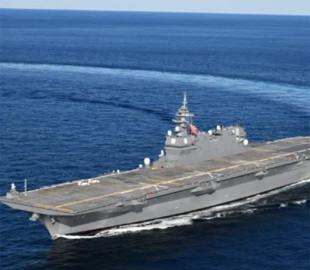
Japan's constitution expressly prohibits the use of any offensive weapons, including aircraft carriers. Therefore, Japanese warships have the ability to carry aircraft on board, but officially they are destroyers.
Although Izumo ships from the very beginning could carry only helicopters on board, many analysts noted that they could accommodate larger aircraft as well. Later, the official representatives of the Japanese armed forces confirmed: the design was designed for the American F-35B — a variation of the Lightning II with vertical take-off and landing (VTOL).
Focus translated Maya Carlin 's article on how Japan's Defense Forces deploy aircraft carriers.
Since the US became the guarantor of Japan's sovereignty after the end of World War II, the size and strength of its armed forces have been cut. The country's constitution itself limits the possession of offensive weapons, one of which is an aircraft carrier. While most developed countries, interested in the security of their seas, have aircraft carriers, Japan is deprived of them. However, there is a strong argument in favor of the fact that helicopter destroyers are a functional replacement for Japanese aircraft carriers.
Hyuga-class helicopter destroyer
In the early 2000s, the Japan Self-Defense Force developed the Hyuga-class helicopter destroyer ( “Hyuga”). At the time of its introduction, the Hyuga and its sister ship the Ise were the largest ships built for the Japanese Navy in the last half century.
These destroyers are well equipped and have similar technical characteristics to the Italian light aircraft carriers Giuseppe Garibaldi and the Spanish Principe de Asturias. Both ships are armed with the Phalanx Close Combat System (CIWS) for self-defense and the 16-piece VLS system equipped with the Evolved Sea Sparrow Missile surface-to-air missiles. These two ships are mostly used for anti-submarine defense (ASD).
Although none of the ships carry fixed-wing aircraft, their size and shape closely resemble light aircraft carriers.
Izumo-class destroyer
The Izumo-class ships were designed in the image and likeness of their Hyuga predecessors. and have even larger sizes. They were also intended for anti-submarine operations, placing on board seven PCHO helicopters and two search and rescue helicopters. They are equipped with the same CIWS self-defense system as the Hyuga, as well as the SeaRAM missile complex.
Although the Izumo ships could initially carry only helicopters, many analysts noted that they could also accommodate larger aircraft. Later, the official representatives of the Japanese armed forces confirmed: the design was designed for the American F-35B — a variation of the Lightning II with vertical take-off and landing (VTOL).
In 2018, Japan's Cabinet approved modifications that allow the Izumo and its sister ship Kaga to work with F-35 fighter jets. Although some say this gives them the ability to conduct offensive operations, which violates the Japanese constitution, the Japanese government maintains that they are for purely defensive purposes.
Japan's secret aircraft carriers?
So? otherwise, in 2021, a US Marine Corps F-35B aircraft successfully took off and landed on JS Izumo. Although the ship is still commonly referred to as a destroyer or helicopter carrier in order not to violate Japanese law, this successful test means that it is now effectively an aircraft carrier.
With lengthy modifications for the Izumo and near completion for the Kaga, Japan now has its first aircraft carriers in decades.
Izumo aircraft carriers — a step in the right direction
The Japan Maritime Self-Defense Force can now operate far from the air cover of the Japan Self-Defense Force, providing a depth of defense not previously available. Although Izumo's ships — a step in the right direction, these destroyers do not have offensive capabilities and are therefore incomparable to other aircraft carriers, including American, British, Chinese or Russian.
About the author
Maya Carlin — author of national security articles for The National Interest, an analyst at the Center for Security Policy, and a former Anna Sobol-Levi Research Fellow at IDC Herzliya in Israel. Her articles have appeared in many publications, including The National Interest, the Jerusalem Post, and the Times of Israel. You can follow her on Twitter: @MayaCarlin.

